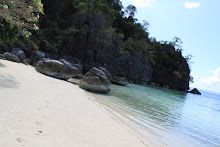

The hills are located on a plateau, bounded by the towns of Butuan, Carmen and Sagbayan. The hills rise separately from the surrounding lowlands. Each is distinct from the other, either in shape or size. From afar, they seem to be like huge candy drops.
Science can’t provide an adequate explanation on how these hills were formed. Some scientists explain vaguely that it is a geologic phenomenon associated with volcanism some 750,000 years ago. Others mention the “karst” theory. When these theories proved inadequate to explain such an occurrence, people resorted to legends and myths to somehow explain the unusual formation of these hills.
But
Another religious attraction is the
There is also Badian Springs in Valencia. Often dubbed as the "spring of eternal flow", it is located 40 kilometers from Tagbilaran City, the province's capital. It was said to have been built by a giant eel whose body carved an opening where the forest waters gush forth.
Another famous landmark in Bohol is the watchtower and wooden cross of Punta Cross, Maribojoc. The wooden cross stands behind the moss-covered watchtower (built during the Spanish era) which served as a lookout for the marauding Moro pirates.
The Blood Compact marker in Tagbilaran City commemorates the historic Sandugo (blood compact) between Miguel Lopez de Legaspi, a Spanish conquistador, and Datu Sikatuna, a local chieftain. The two drank, from a common cup, a potion mixed with drops of blood from each other's arms to symbolize peace and friendship.
The Hinagdanan Cave is another interesting sight. It has an underground swimming pool with fresh, cool spring water.
Then there is also the President Ramon Magsaysay camp, a camping site surrounded by dense forests. Another park can be found in Barrio Maombong, Garcia Hernandez. Called Roxas Park, it has two natural swimming pools with mineral water gushing out of the rocks.
Bohol lies in the heart of the Visayas, between Cebu to the northwest and Leyte to the northeast. Dotting Bohol's entire coast are pristine beaches -- Bikini Beach, Doljo Beach, Laya Beach, Clarin Beach and several others. Ringing Bohol are several smaller islands known for their diving sites.
You can also find centuries-old houses and churches dating back to the 15th and 16th centuries.
Indeed, the province is an ideal place for adventure, for rest or contemplation or for simply having fun.
Photo credits:
Blood Compact photo taken from www.bohol-philippines.com
Chocolate Hills photo taken from wikipedia.org

No comments:
Post a Comment